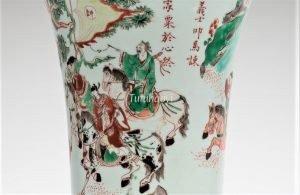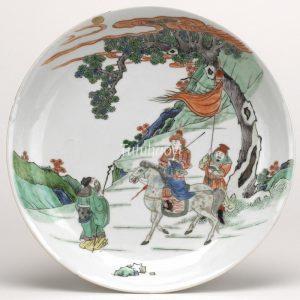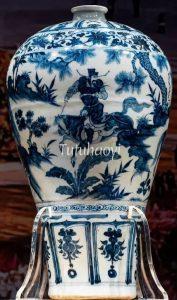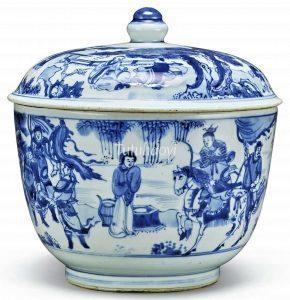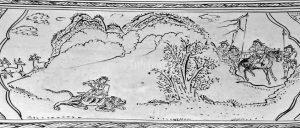Showing Results Containing
The following article is a discussion of the substitution of a mythical beast for a horse as Grand Duke Jiang’s mount on three classic porcelain vases adorned with the same story scene of ‘Bo Yi and Shu Qi Trying to Stop the Mighty Zhou Army’. It ...
Through analysing a famous theme that depicts Bo Yi and Shu Qi Stopping the Zhou Army, Dr Yibin Ni has compared a number of porcelain vessels from Ming and Qing dynasties, and demonstrated his unique insight which can facilitate the correct dating...
The Empty Fort Strategy is the thirty-second of the Thirty-Six Stratagems (三十六计), a psychological ploy that feigns strength through an appearance of calm to mislead the enemy into retreat. In ancient times, it was used not only to defend cities but also in situations where one was heavily outnumbered.
In the ficti...
In Chapter 84 of Romance of the Three Kingdoms, ‘Lu Xun Burns Seven Hundred Miles of Camps; Kongming Lays Out the Eight Formations,’ the flames of Lu Xun (陆逊, 183–245)’s assault drive Liu Bei into headlong flight. Eager to finish his foe, Lu Xun presses on to the riverbank, unaware that he has entered the fabled...
Legend of the Epiphyllum (Tanhua Ji 昙花记) is a late Ming dynasty drama written by the accomplished scholar Tu Long (屠隆, 1542–1605), composed during the Wanli reign. Renowned for his achievements in literature, art, and Buddhist philosophy, Tu Long described this legendary play as a work intended ‘to expound the l...
The Royal Hunt at Xutian is a pivotal moment in Chapter 20 of Romance of the Three Kingdoms (《三国演义》) by Luo Guanzhong (罗贯中). This episode highlights Cao Cao (曹操) as a domineering minister who ‘held the emperor hostage to command the feudal lords.’
In this scene, Cao Cao arranges a hunting...
The story comes from the Records of the Grand Historian (Shiji 史记), specifically the biography of the Marquis of Huaiyin. It recounts an episode from 206 BCE, during the power struggle between the Chu and Han kingdoms.
Han Xin 韩信, well-versed in military strategy, joined Liu Bang 刘邦 duri...
This scene is taken from Vol. 24 of the 14th-century Chinese historical novel Romance of the Three Kingdoms (三国演义 Sanguo Yanyi).
In the 15th year of Jian’an (AD 210), Cao Cao (曹操) completed the construction of Bronze Sparrow Terrace in Ye City (modern-day Handan, Hebei Province, China). To cele...
This scene was from a popular play ‘The Story of the White Hare’ (Bai Tu Ji 白兔记) and was much admired during the Ming dynasty.
Liu Zhiyuan 刘知远, the hero of the play set during the turbulent Five Dynasties (907–960), became an orphan when he was a teenager. His affluent neighbour looked after him and later...
One day during the Tang dynasty (618-907), Li Keyong (李克用, 856-908), the Prince of Jin (晋王), went out hunting with an entourage of dozens of soldiers, when he encountered a woodcutter in a quiet valley. The woodcutter told Li that The Flying Tiger Hill nearby was an ideal hunting ground. The prince told him that he had d...
There are thirty-six well-known stratagems (三十六计) that the Chinese politicians, strategists, and businessmen have been using for millennia. One of them is the ‘ruse of inflicting pain on oneself or one’s comrades to gain the enemy’s trust’. The scene depicted here is its most famous illustration.
Zhou Yu (周瑜) was ...
When Prefect Mao Bao 毛宝 was stationed in the city of Wuchang 武昌, Hebei province, during the Jin dynasty (晋 265-420), there was a story about a white tortoise who repay...
Bo Yi (or Boyi, 伯夷) and Shu Qi (or Shuqi, 叔齐) were sons of the ruler of Guzhu (孤竹), a vassal state of the Shang dynasty (商朝, 16th-11th cent. BCE). As the king was getting old, he wanted Shu Qi, his youngest son, to inherit his throne. However, when the father died, Shu Qi asked Bo Yi to take over th...
